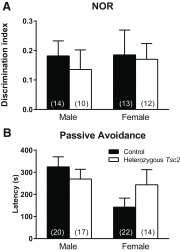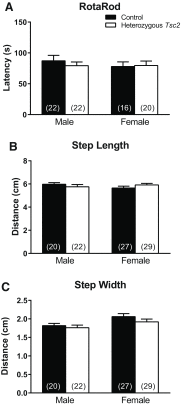Sex-Selective Effects on Behavior in a Mouse Model of Tuberous Sclerosis Complex
- PMID: 32303566
- PMCID: PMC7196723
- DOI: 10.1523/ENEURO.0379-19.2020
Sex-Selective Effects on Behavior in a Mouse Model of Tuberous Sclerosis Complex
Abstract
Tuberous sclerosis complex (TSC) is an autosomal dominant genetic disorder that is caused by a mutation in either TSC1 or TSC2 TSC affects multiple systems of the body, and patients with TSC display a range of neurologic and behavioral manifestations including seizures, intellectual disability, autism spectrum disorders, attention deficit hyperactivity disorder, anxiety, and mood disorders. Whereas behavioral phenotypes of many mouse models have been studied, the effects of sex have, for the most part, not been explored. We studied adult male and female Tsc2 heterozygous and control mice to investigate the influence of sex and genotype on behavior. On a test of social preference, Tsc2 heterozygous mice, regardless of sex, demonstrated lower preference for the stranger mouse than control mice. In the open field, Tsc2 heterozygous males and control females habituated to the open field with decreasing anxiety-like behavior over time, whereas Tsc2 heterozygous females did not show habituation to the open field environment. We did not find any statistically significant effects of genotype on open field activity, learning and memory or motor function. Our results highlight phenotype differences in Tsc2 heterozygous mice, some of which are influenced by sex. A consideration of how sex influences the behavioral phenotypes of TSC is critical to develop a more complete understanding of the disorder and better target future pharmacological treatments.
Keywords: sex differences; tuberous sclerosis complex.
Copyright © 2020 Saré et al.
Figures







References
-
- Au KS, Williams AT, Roach ES, Batchelor L, Sparagana SP, Delgado MR, Wheless JW, Baumgartner JE, Roa BB, Wilson CM, Smith-Knuppel TK, Cheung MY, Whittemore VH, King TM, Northrup H (2007) Genotype/phenotype correlation in 325 individuals referred for a diagnosis of tuberous sclerosis complex in the United States. Genet Med 9:88–100. 10.1097/gim.0b013e31803068c7 - DOI - PubMed
-
- European Chromosome 16 Tuberous Sclerosis Consortium (1993) Identification and characterization of the tuberous sclerosis gene on chromosome 16. Cell 75:1305–1315. - PubMed
Publication types
MeSH terms
Substances
Grants and funding
LinkOut - more resources
Full Text Sources
Medical
Molecular Biology Databases
